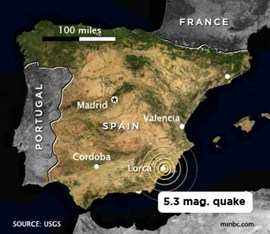

The quakes, of preliminary magnitudes 4.4 and 5.2, killed at least 10 people and injured dozens in Lorca, a town of about 91,000 in the municipality of Murcia, government officials said.
Breakingnews.com: Updates on Spain’s quakes
One woman died in the collapse of a new three-story building, the newspaper El Pais reported. Her child was rescued alive, but others were feared trapped in the rubble.
Three people, including a teenager walking his dog, were killed after being struck by falling building parts, the newspaper said.
Local authorities told NBC News that several buildings collapsed or sustained damage and authorities fear more victims could be trapped.
The epicenter was in the Sierra de Tercia area northeast of Lorca, El Pais reported. The quakes were felt strongly in several villages in the region.
Video: Two earthquakes, casualties reported in Spain (on this page)
„The population is scared and are very afraid to return to their homes. The whole of the center of Lorca has been seriously damaged,” a delegate from the central government in Murcia told national radio. „There are thousands of very disorientated people.”
Dozens of injured people were being treated at the scene and a field hospital was set up, officials said. About 270 patients at a hospital in Lorca were being evacuated by ambulance as a precaution after the building sustained minor damage, the Murcia regional government said.
The temblors opened cracks in roads and overpasses, and there were reports of cars trapped in a collapsed tunnel, according to El Pais.
Large chunks of stone and brick fell from the facade of a church in Lorca as Spanish state TV was broadcasting live from the scene.
A large church bell was also among the rubble. The broadcaster reported that schoolchildren usually gather at that spot around that time, and if it had happened 10 minutes later, a „tragedy” could have occurred.
Nervous groups of residents gathered in public places, talking about what happened and calling relatives and friends on their cell phones.
Spanish TV showed images of cars that were partially crushed by falling rubble, and large cracks in buildings.
„I felt a tremendously strong movement, followed by a lot of noise, and I was really frightened,” the newspaper El Pais quoted Lorca resident Juani Avellanada as saying.
Another resident, Juana Ruiz, said her house split open with the quake and „all the furniture fell over,” according to El Pais.
Many residents decided to spend the night camped out in parks and other open spaces, fearing aftershocks and because of structural damage to their homes, according to state TV footage.
This was the deadliest quake in Spain since 1956, when 12 people died and some 70 were injured in a quake in the southern Granada region, according to the National Geographic Institute. It says Spain has about 2,500 quakes a year, but only a handful are actually noticed by people. Spain’s south and southeast are the most earthquake-prone regions.
Recent quakes in Murcia:
A quake of 4.8 on Feb. 2. 1999, that caused damage to the village of Mula.
A 4.6 quake in January 2005 in Bulla in Murcia that damaged more than 200 properties.
A similar quake happened in August 2002, although it was slightly smaller at 4.5.
The U.S. Geological Survey’s National Earthquake Information Center in Golden, Colo., had slightly different magnitudes for the temblors Wednesday.
Source:
http://www.msnbc.msn.com/id/42993156/ns/world_news-europe/
